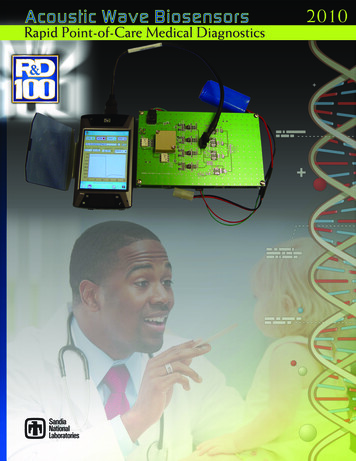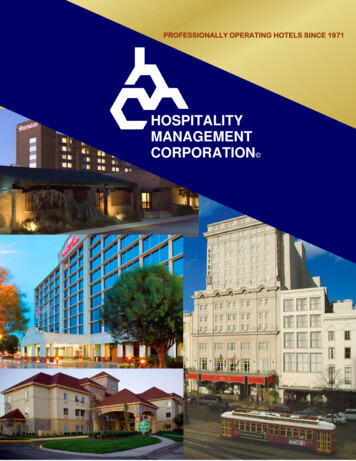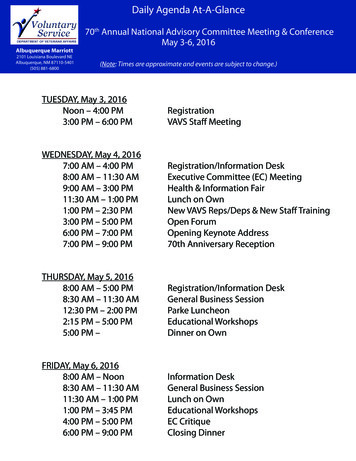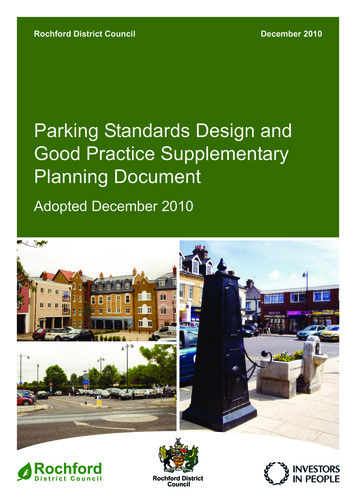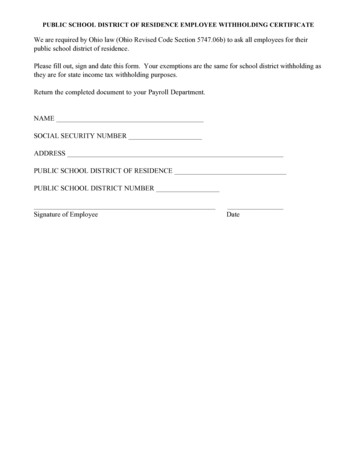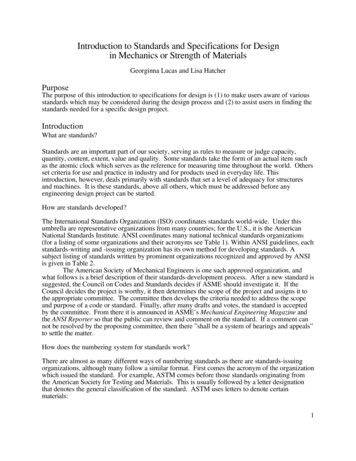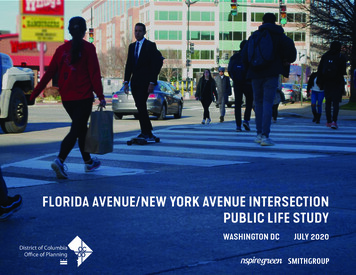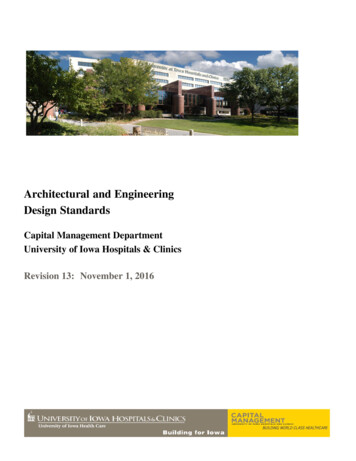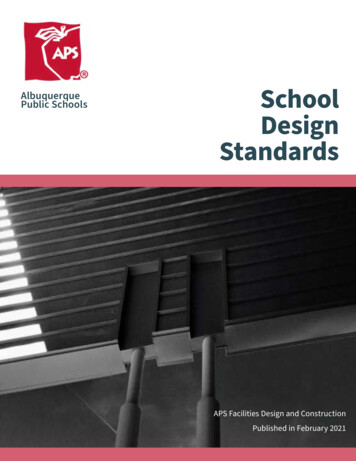
Transcription
AlbuquerquePublic SchoolsSchoolDesignStandardsAPS Facilities Design and ConstructionPublished in February 2021
Table of Contents» Introduction And Overview 5» General Site and Facility Design Concepts 8» School Sites and Facilities Overview 9» Site Development 11» Safety/Security 15» Site and General Utility Requirements 16» Landscaping 19» Site Recreation 26» School Design and Construction Integrity 29» General 30» Accessibility 30» Building Components 30» Signage 35» Common Educational Areas and Support Spaces 36» Restrooms and Drinking Fountains 40» Special Education Program Overview 42» Community Education / After Hour Use 46» Programmed Spaces: Elementary Schools 47» Corridors And Lobby Areas 52» General Needs For All Elementary School Classroom Spaces 52» Support Spaces 57» Site Recreation 61» Children’s Accessible Elements Table 62» Programmed Spaces: Middle Schools 65» Needs Analysis for Standards-Based Middle Schools 66» General Needs for All Middle School Classrooms 71» Administrative Offices / Support Areas 80» Programmed Spaces: K-8 86» Programmed Spaces: High Schools 95» APS High School 96» Academies 96» Ninth Grade Academy 96» Upper Grade Career Academies 97» Career Academy Precedents: 97» Small Learning Communities (SLC’s) 97» Space Needs summary table 98» Secure Entry vestibule 98» Central Administration 98» Special Education Center 100» Media Center 100» Graphics/AV Production Classroom and Lab 102School Design Guidelines 20212School Design Guidelines 2021Table of Contents3
» Computer Labs 103» Professional Room 103» Book Room 103» Performing Arts Center (PAC) 103» Auditorium 103» Physical Education and Athletics Sports 107» Student Activities Center 117» School Nurse 117» Student Commons /Central Food Service/Cafeteria 119» Kitchen 120» Snack Bar 120» Storage / Custodial 121» Outside Dining Patio 121» Academy Areas 122» Academic Areas 123» Project-based learning labs 126» Special Education Spaces 127» Teacher Home Base 127» Teacher Workroom 128» Specialized Classrooms 128» Flexible Elective Classrooms And Other Optional Spaces 133» Other School Support 138» Appendices 142» Appendix A: High School Space Table 143» Appendix B: Special Education Design Standards 154» Appendix C: Student Health Equipment 166» Appendix D: Food Service 167» Appendix E: Kitchen Appliance Guidelines 168» Appendix F: Active Panel 169» Appendix G: Kiln Standards 170» Appendix H: Ice Machine Standards for High School Athletics172» Appendix I: Technology Education Equipment 175» Appendix J: Wireless Installation Requirements 177» Appendix K: Transportation 178» Appendix L: Sign Standards 182» Appendix M: Library Services Instructional Materials Recommendations for K-5Libraries 183» Appendix M: Library Services and Instructional Materials Recommendations forHigh School Libraries 185» Appendix O: Fencing Requirements 187» Appendix P: NM 811 Method 188 Section 01IntroductionIntroductionAnd OverviewSchool Design Guidelines 2021Table of Contents45School Design Guidelines 2021Introduction and Overview
The requirements outlined in this Introduction are for specific site and facility parameters notcovered in the more “performance based” standards that follow. Requirements for all projects:Introduction and Overview» It will serve as guideline for new construction as well as existing facility renovations forall sites and buildings.» It outlines broad and specific criteria to support the educational and other needs of thedistrict.» It addresses adequacy, health and safety, and maintainability.» It is informed by current, adopted APS facility and curriculum practices, nationalstandards, and the aggregate input from a committee composed of APS administrativepersonnel, content area experts, principals, and community representatives.» It is organized to outline minimum, general expectations and approaches for ALLbuildings and sites serving all grade levels and those staff serving them.» It presents very specific requirements for ALL buildings and sites for each school level oreducational/organizational paradigm: Elementary, Middle, K-8, High School.» It shall be used in accordance with and complementary to all published building systemand component standards published in the Department’s website. Clickable linksbelow:Aluminum Storefront SpecificationMechanical VRF Pre-Selection ProcessInterface Carpet Tile SpecificationsPlayground StandardsMannington Carpet Tile SpecificationsCustom Plastic Laminate CaseworkStandardsDoor Hardware StandardsPolished Concrete FinishingPortable Building Electrical and Special Systems ServiceBlueprint – E-201Portable Building Electrical and Special Systems ServiceBlueprint – E-202Electrical Design StandardsSolar PV GuidelinesGlazing and Window StandardsRoofing Design Guidelines & SpecificationsLEEDv4 GuidelineRoof Drain No Hub CouplingMechanical Design StandardsMechanical Design Standards Appendix AKey to parenthetical and related supplementary notations:*** Refers to information complementing or expanding the more general policy or standard.LEED : Refers to elements of the LEED for Schools process that will possibly influence the approach, execution, or optionsevaluated for the referenced policy or standard.FD C and M&O Notes: Refers to information that directly impacts the department of Facilities Design Construction (FD C)and Maintenance & Operations (M&O) and often provides some restrictions or lessons learned to be used in executing thestandard.School Design Guidelines 2021Introduction and Overview61. The contract Architect / Engineer (A/E) shall coordinate all work with the APS Facilities Design andConstruction (FD C) project team and participate in a School Building Committee process.2. A utilization will be provided to the A/E by APS FD C and Capital Master Plan (CMP) prior to thedesign of each Project. The CMP utilization will define the specific spaces required for each project.The APS Standards will define the square footage and character requirements for each of thespecified spaces.3. The school facility shall accommodate the education of all students. The A/E will coordinate withFD C and APS Capital Master Plan (CMP) to determine special education facility requirements.Facilities shall support universal design and accessibility.4. Grade level accommodations:Elementary SchoolKindergarten, 1st, 2nd, 3rd, 4th, and 5th grades(Some schools have pre-K)Middle School6th, 7th and 8th gradesK-8 SchoolKindergarten, 1st, 2nd, 3rd, 4th, 5th , 6th, 7th,and 8th gradesHigh School9th, 10th, 11th, and 12th grades5. New facilities shall be designed and constructed in alignment with phasing identified in the school’ssite master plan. Phases shall be designed and constructed to limit disruption to previous phase(s)of work.6. The contracted A/E will thoroughly review files of the APS Real Estate Director to ensure that legaldescription, boundary description, vacations, easements, rights-of-way, property lines, and zoningissues are clarified. If available, existing surveys, drainage plans, and public infrastructure plans aregenerally on file with FD C.7. The contracted A/E will meet to clarify with the City / County / utility companies on drainage,street access, zoning, utility availability, sector development (or other area plan restrictions), fireprotection, easements, right-of-way, and other applicable considerations.8. Where known, APS will notify the A/E of extension requirements for telephone, cable, or power fromsubstation; water / sewer line taps requirements; fire hydrant requirements; up and down streamstorm water requirements; number of meters APS will allow; and street extensions.9. These standards do not specifically address furnishings. The contract Architect will coordinate theconfiguration of spaces requiring furnishings with the FD C Interiors Department.10. The A/E and FD C Interiors Department will coordinate and agree on colors, surfaces, and level ofmaterial quality based on these standards and allotted budget. Once settled, FD C will then sharethe information with the school.11. All new stand-alone buildings shall follow the sustainability process developed by the U.S. GreenBuilding Council’s Leadership in Energy and Environmental Design or LEED for Schools for NewConstruction and Major Renovations. The district strives for all stand-alone new school buildings tomeet a minimum of LEED for Schools Silver Certification. Policies and Standards influenced by theLEED process are noted when possible.12. The A/E shall consider and employ the principles of Universal Design.13. APS reserves the right to exceed the PSFA Adequacy Standards for site and facility areas noted inthis document.7School Design Guidelines 2021Introduction and OverviewIntroductionIntroductionThis one-volume design standards replaces the individual separate school and site standardspreviously published by the Albuquerque Public Schools [APS]. This volume‘s functions aremanifold:
SCHOOL SITES AND FACILITIES OVERVIEWSection 02General Site and FacilityDesign ConceptsSchool Sites and Facilities OverviewSite DevelopmentSafety/SecuritySite and General Utility RequirementsLandscapingSite RecreationSchool Design Guidelines 2021General Site and Facility Design Concepts10 acresMiddle School20 -25 acresK-8 School25 acresHigh School45-50 acres3. In addition to the permanent building, the site should be able to accommodate a statedquantity of future portables to be confirmed during programming.4. An enclosed circulation school. Areas of recently constructed schools (permanent GSF;excludes portables):Elementary School79,000 gsfMiddle School170,000 gsfK-8 School217,000 gsfHigh School349,000 gsf5. APS FD C assigns 25% tare to facilities. Tare space includes circulation (hallways, lobbies,vestibules, etc.), wall thickness, custodial space, general storage, and restrooms (exceptwhere fulfilling specific program requirements, i.e. nurse’s restroom). Tare space excludesmechanical rooms, IT rooms, electrical rooms, specific programmed storage, and specificprogrammed restrooms.6. Special Education demographics may impact the size/design of school. See SpecialEducation Program Overview and Appendix B for Special Education space standards.7. Accommodate the enumerated number of student population dictated by CMP’s UtilizationStudy/ Projections. The table below depicts recently built ground-up schools:General Site & Facility Design Concepts»»»»»»Elementary School8Elementary School650 student-base population with ability to increase / accommodate1,000 students using portable classrooms (permanent area for 8 portableclassrooms; interim area for up to 12)Middle School1,200 student-base population with ability to increase to 1,500 students usingportable classrooms (permanent area for 8 to 12 portable classrooms)K-8 School1,200 student-base population with ability to increase to 1,500 students usingportable classrooms (permanent area for 8 to 12 portable classrooms)High School2,100 student-base population with ability to increase to 2,650 students usingpermanent or portable classrooms (permanent area for 8 to 12 portableclassrooms)9School Design Guidelines 2021General Site and Facility Design ConceptsGeneral ConceptsGeneral Concepts1. The school location should be convenient to the student population in a manner thatminimizes busing and provides student, parent, and community controlled safe pedestrianand vehicle access to the school.2. Site the school on adequate area of land in a primarily residential area; ideal land sizes ofrecent schools:
8. Meet specific program area/SF requirements defined in these Standards.9. Meet specific educational, instructional, and functional needs of specified activities.10. Provide a pleasant environment for students, teachers, and staff and be a positive additionto the community.11. Provide a safe environment that promotes learning opportunities in accordance withrelevant codes and ordinances.12. Allow for team teaching options in part of each group of classrooms. (Use of extra widedouble doors has worked well in many schools.)13. Restrooms distributed to be convenient to students and staff.14. Courtyard(s)/outdoor learning spaces that can be used for educational purposes.15. Be designed for cost effective operation and maintenance.16. Be adaptable as center for community use and education, fine arts education, and/or beforeand after-school programs.17. Provide opportunities to adjust to programmatic (instructional and community) andtechnological changes:» Flexibility of existing spaces to meet a number of purposes.» Ability to expand.» Ability to accommodate new technologies into learning environments.18. Organized in clear and consistent manner featuring:» Single point-of-entry.» Ease of supervision and security (controlled building access, functional organization andseparation for after-hours use).» Locate common-use facilities (media center, cafeteria/kitchen, gym, PAC, restrooms) forafter-hours use while securing the remainder of the school.» Locate workrooms in convenient proximity to the administration office and staff areas.» Natural light to learning areas.» Separation of noisy from quiet activities.» Universal design.19. Some APS schools have a School Based Health Center (SBHCs) or a Community BasedHealth Clinic (CBHC) on campus. See CMP Utilization for program needs.» These programs are run by third party providers. APS provides the required spaces,power, data, and regular janitorial services.» The SBHC provider provides a variety of services (not all services are at each site) suchas primary care, preventive care, behavioral health and dental (very limited). All the APSSBHCs serve only students at the school they are housed.» A CBHC serves the students at the school and also has hours when the community hasaccess to the clinic20. Refer also to each individual school level standards (Elementary School, Middle School, K-8,and High School).School Design Guidelines 2021General Site and Facility Design Concepts10SITE DEVELOPMENTElements of site development include the harmonious blend of the following elementsfor the school site, perimeters, parking lots, and adjacent streets. Aesthetic appeal andease of maintenance are paramount concerns.Areas adjacent to an existing or planned housing development shall be buffered fromthe houses. Drainage or blowing sand impact on neighbors is not allowed. Considerimpacts of fugitive dust and storm water run-off in project planning.» Off-Site Student Pedestrian Access, Sidewalks, and Access Streets» While FD C and the contract A/E will meet with the BLUZ team to identify and minimizehazards where feasible, off-site sidewalks, access streets, and circulation are notwithin the jurisdiction of APS. “Park and walk” use of adjacent neighborhood streets isdiscouraged. The following are desirable, but not within APS’s control:» Signals and signs to permit safe pedestrian entrance to and exits from the schoolarea.» Barrier-free sidewalks connecting schools to adjacent residential areas.LEED : If public bus service is available, consider provisions to safely provide student / staff / parentaccess to bus stop. LEED points are available if ½ mile to light rail or ¼ mile to bus transit routes.» On-Site Pedestrian Access/Sidewalks» The pedestrian entry to the site shall be clearly defined. Paved sidewalks shall connectall school activity areas, including portables, (to provide accessibility and avoid unduemaintenance in interior areas from mud or sand).» On-Site Bicycle Use» Provide fencing (lockable) around a concrete pad for bicycle storage.» Provide bicycle racks.LEED : Bike amenities qualify for points.» Accessibility» Provide ADA compliant access to facilities (universal access preferred). Use ramps,handrails, and curb at building entrances, parking areas, playgrounds, and pedestrianwalks in accordance with the New Mexico Building Code, American National StandardsInstitute, specifications for designing buildings and facilities accessible to and usable bypeople with physical disabilities.***Provide easy access to the main office and to key public-use spaces (gyms, appropriate restrooms,performance area, likely voting location, media center, etc.). Access needs to have appropriateparking area; a drop-off space; have no barriers; be well lit; and not compromise general buildingsecurity.LEED : Having joint use space with easy access can qualify for points.11School Design Guidelines 2021General Site and Facility Design ConceptsGeneral ConceptsGeneral Concepts
» .with lifts (check with transportation regarding the size of the buses to be usedat each particular site) as well as after-school daycare vans.» Design bus lanes per bus configurations and turning radius requirements.» See Appendix K for bus configurations and turning radius requirements.» Provide separate bus lanes from parent drop off and pick up lane.» Provide a separate drop off for wheel chair buses (Typically is a mid-size bus).» Bus boarding zones:» Provide a fence at boarding zones.» Load buses directly from the adjacent sidewalk (no walking around or betweenbuses).» Include way-finding design elements for younger students to find their bus.Consider color coding.***Some recent school construction projects have included signage to be translated into Spanish.Verify with building committee.» School Sign:» The school shall have an integral sign mounted on the building with the nameof the school and the street number. The school may also have a free standingmonument sign with the name of the school and street number located near thestreet. The monument sign is not to be confused with a marquee sign (refer tosignage section in these Guidelines).» Flagpole:» Provide one flagpole that is a minimum of 20’ tall with sheathed metallic flagsnaps. The pole shall be one piece, non-tilted, aluminum.» Consider new technology (swipe on and off buses) at bus loading area.*** The contract A/E is required to meet with APS Transportation and BLUZ team for approval of the busloading area layout and entry / egress turning schemes.***The contract A/E shall confirm with APS CMP and Transportation the intensity of bus lane use.» Student Drop-Off / Pick-Up» There shall be a separate area for the drop-off and pick-up of students byindividual vehicles that shall not conflict with other vehicular or pedestrianpathways and provides for the safe loading and unloading of students. This hasbeen a consistent safety concern for schools as the number of walking studentshave tended to diminish. The area should allow for a right door exit from thevehicle to the curb. Employ fencing to control pedestrians from walking in frontof waiting cars. No parent cars in bus lanes.» Provide separate kindergarten drop-off and parking area when site allows.» Vehicular Circulation» There shall be clear, separate, distinct and safe on-site circulation paths for pedestrians,school buses and staff, visitor, and service vehicles. Multiple access points for vehicles arepreferred.*** M&O Notes: Posts for signs to be #3 U-channel. Sign hardware shall be vandal-guard. Fence mountedsigns to have 3.5” aluminum plates. All traffic signs for directions, safety, traffic control, and ADA will beinstalled by general contractor. The signs that are mounted on buildings to be attached on all cornersof the sign and high enough to prevent graffiti or vandalism. Identification numbers or letters of schoolnames etc. will be high enough off ground and adhered sufficiently to inhibit vandalizing.LEED : The nature of parking needs for APS violates the parking principles of LEED to reduce parkingimpact and reliance on one driver vehicles.*** To the extent possible, provide the length of the drop-off roadway to accommodate stated amount ofvehicles cued for pick up and drop off; to be discussed with BLUZ Committee.» Vehicular Entrances / Exits» If feasible, buses should not be dependent on other on-site traffic movement inorder to exit, since buses all exit at the same time turning both directions fromthe site drives.» Bus Loading / Unloading:» During programming, confirm the number of buses at a school with APSTransportation.» Strive to provide separate bus loading/unloading zones accommodating therequired number of buses for that school that do not conflict with other vehicularor pedestrian pathways and provides for the safe loading and unloading ofstudents.» The loading area shall be able to accommodate up to 80% of the schoolpopulation in a safe and orderly manner and load students from the curb directlyinto the bus door without passing between or behind buses or cars. Confirm theprojected number of students and buses based on the school’s projected studentpopulation. Provide curb access area for the projected number of SPED busesSchool Design Guidelines 2021General Site and Facility Design Concepts12» Service / Emergency Access» Appropriate access to all areas of the site by service, garbage, and emergencyvehicles shall be properly identified. Design of surfaces for maintenance vehiclesshall be appropriate for the weight and clearance. Truck access to the kitchenand garbage trucks will not pass through general pedestrian or play areas. Designdumpster area and garbage truck approach per City of Albuquerque details, and/or other jurisdictions if applicable.***The contract A/E’s will meet with local Fire Department to determine access points for fire trucksto site. Allow for fire hose access to all parts of the school and fire trucks to portable area. Access tothe nurse’s office shall be direct and easily identifiable for emergency medical personnel. APS NursingServices has requested a reserved area for emergency medical service vehicles at every school.13School Design Guidelines 2021General Site and Facility Design ConceptsGeneral ConceptsGeneral Concepts » Main Entry» Access points (See Safety/Security section for additional single-point of entryrequirements):» For security, limit the number of school access points. The main entrance tobuildings or building complexes shall be clearly defined by employing, primarily,architectural elements, and, secondarily, reinforced by landscaping, directionalsignage, and other means. Signage shall clearly identify car, bus, delivery,handicapped parking, and drop-off areas; different parking areas; location ofaccessible routes; and route to the office.
» Street / Parking Area Condition» Streets and parking areas shall have the appropriate pavement profile(s) forvehicles using them. Consult the project geotechnical study, and account for alltypes of traffic that will transverse the pavement.» Discuss with BLUZ committee as to jurisdictional responsibilities of these subjectadjacent areas.» Parking Standards and Signage» Coordinate facility parking requirements with the NM Building Code.» There shall be adequate, safe parking for staff and visitors. Parking areasshall be paved and separate from other access ways. Parking areas shall beequipped with LED security lighting (including rough-ins for security camerasas afforded and needed). Design lighting in compliance with New Mexico NightSky Protection Act, City Ordinances and Neighborhood Regulation and per APSElectrical Design Standards.» Provide 3 designated parking spaces with signs for the principal and 2 otherpersonnel to be determined during design.» Provide 20 - 30 visitor parking spaces with signage. Prefer visitor parking and partof staff parking centralized for control of access to the office.» Provide 1 designated parking space with sign for APS police.» Provide a designated parking area with signage for 1.5 spaces for each teacherand staff member. Prefer visitor parking and possibly part of staff parkingcentralized for control of access to the office.» Install signage in kitchen parking lot. School needs signage for delivery zone andto prevent others from parking in their area.» Schools require a minimum of 3 parking spaces next to kitchen door for earlymorning arrival, and require 3 - 8 parking spaces designated with signage forkitchen staff near the kitchen area. Check with Food and Nutrition Services forrequired kitchen parking spaces during design.» A/E shall confirm parking requirements for other agencies (social services, citydaycare, etc.) with school administration.» Number of handicapped parking spaces, shall be as required per most restrictivecode designated and dispersed between staff and visitor lots.» Provide an M&O parking space with sign.» Provide an emergency vehicle parking space with sign.» Provide signs for parent drop-off lane indicating direction of travel and noparking.» Provide signs for bus lane indicating buses only, no private vehicles or parking.» Provide signage at entrances to direct visitors to the school office. “Visitors mustreport to the School Office”.» Provide signage for green vehicles and/or signage required for LEED points [e.g.tobacco use prohibition, facilities community use availability, etc.]School Design Guidelines 2021General Site and Facility Design Concepts14» Portable Classroom Building Locations» If expressly stated as a consideration during programming, there shall be sufficient roomfor ingress and egress of portable buildings to the site.»»»»*** Provide 32’ improved access lane with straight-in clearance of 96’ for doubles and 60’ for singles.Access lane gate shall be 30’ wide.Define portable classroom areas during planning and design phases.Identify the total number of portables that the site can feasibly support.Plan for infrastructure to support portable classrooms.Integrate portable classroom buildings with other academic learning areas and provideequal access to school support and common-use spaces, as well as open space.» Discuss other potential portable issues, including access, security, condition, etc.» Portable areas shall have main domestic water and sewer lines installed and readyfor connection. In areas with more than 4 doubles, expect installation of a restroomportable.SAFETY / SECURITY» Single Point of Entry» All school facility(ies) shall be accessed from a single point of entry. Parking, drop-off/pick-up, pedestrian routes, and other site access locations shall guide/funnel anyoneentering the campus to the single point of entry.» The single point of entry shall be designed as a secure vestibule. The secure vestibule willrequire all visitors to sign in at the school’s reception area before accessing other areas ofthe school.» The single point of entry applies to all school sites, including both single and multibuilding campuses.» Site Fencing» The site shall be securable with perimeter and/or interior fencing.» Security fencing shall be a minimum of 6’-0” high. Chain-link is acceptable for“back-of-house” areas, while welded wire fence is desirable at more visible areas.» Interior fencing is also referred to as “inter-building” fencing. This strategymay be employed where school buildings serve as barriers/walls and fencing isconstructed between buildings to provide a fenced environment to allow exteriorcirculation for school occupants between and among separate buildings.» The site fencing layout must be coordinated with building egress requirements as wellas the District’s fire evacuation plan and active shooter protocol. Provide egress gateswithin the security fence as required by code, for fire evacuation, and for access to sitefeatures (recreation, playgrounds, parking, etc.).15School Design Guidelines 2021General Site and Facility Design ConceptsGeneral ConceptsGeneral ConceptsLEED : Design recommendations relating to permeable paving areas and water harvesting impact scoring.» Provide student parking area at high schools.» Consider joint use of parking area for band use. Joint use requires area free oflight poles and special striping for band practice.
» Egress gates shall be exit-only, except where approved for re-entry with card access bythe APS staff architect and security team representatives.» Install perimeter fencing on the property line. Coordinate requirements with the APS staffarchitect and APS Real Estate Department.» The site fencing layout must be coordinated with joint-use areas. The school shall beable to secure and use joint-use space during school hours. Coordinate requirementsfor community use of joint use areas with the APS staff architect and APS Real EstateDepartment.» Provide signage at perimeter and joint use fences. Coordinate signage requirements withthe APS staff architect and the APS Real Estate Department.» Vehicle gates may be required within site security fencing for maintenance access and firelanes. Coordinate locations with the APS staff architect and M&O.» In addition to site security, fencing may be used to protect students/staff from traffichazards, steep slopes, drainage ponds.» Refer to Appendix O in this document for detailed fencing requirements.» Site Security Lighting» Sites shall have illuminated parking areas, walks, entrances, portable areas, and exteriorbuilding areas for both safety and security purposes.» Exterior lighting shall meet Illumination Engineering Society (IES) recommendations.LEED : ‘Night sky’ laws will influence the design of this lighting.LEED : Illuminate areas as required for safety, comfort, and expected night use to minimize glare ontoneighboring land or to sky. Put lighting on timer to allow shut-off.» Cameras (CCTV)» Coordinate camera configuration during design reviews, including 50% and 95%.» Coordinate the locations and configurations of exterior and interior cameras with the APSstaff architect and APS security team.» Provide a perimeter view of the building.» Confirm current camera technology with APS staff architect / security team.» Locate cameras efficiently; avoid doubling
School Design Guidelines 2021 General Site and Facility Design Concepts 11 School Design Guidelines 2021 General Site and Facility Design Concepts ftffff ˆ ˇ ff ftffff ˆ ˇ ff 8. Meet specific program area/SF requirements defined in these Standards. 9. Meet specific educatio

